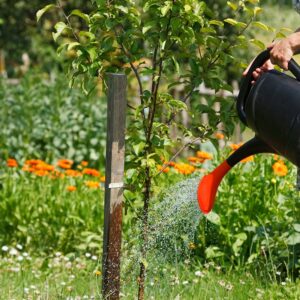Helping your tree survive and thrive under harsh conditions
It’s Summertime in Texas, and that means one thing: it is hot. While older, more established trees are well adapted to the heat and humidity, younger and newly planted trees will struggle to thrive under these harsh conditions, causing stress to the tree that can lead to stunted growth, decay and even death.
Learn more about two easy things you can do at home to help relieve the stress on your tree during the Summer, helping it reach its full potential:
Properly Water Your Tree
 Like us, water is important in the basic life functions of a tree. Young or newly planted trees have not had the time to grow an extensive root system that older trees have. While the tree is growing this root system, it is important to supply it with a regular, deep watering. While temperatures stay above 90 degrees, you should water your tree for 2-3 minutes every 2 to 3 days, ensuring that the area directly around the trunk of the tree gets thoroughly saturated.
Like us, water is important in the basic life functions of a tree. Young or newly planted trees have not had the time to grow an extensive root system that older trees have. While the tree is growing this root system, it is important to supply it with a regular, deep watering. While temperatures stay above 90 degrees, you should water your tree for 2-3 minutes every 2 to 3 days, ensuring that the area directly around the trunk of the tree gets thoroughly saturated.
The amount of water and frequency of watering will vary based on your soil, location and species of tree, so pay close attention as you water it. If there is standing water puddling around the tree that doesn’t drain between watering, consider watering less, letting the pooled water soak in. If the tree is in a shady spot that doesn’t get exposed to direct sunlight all day, the tree may not require as much water as a tree in direct sun all day.
Some species of tree require more water while others don’t need much at all. There are plenty of resources available to help identify and find the water needs of your tree online that should help you create the perfect watering schedule.
Mulch Your Tree


This layer of mulch will help retain moisture around the roots of the tree, letting the roots absorb the water that would otherwise be lost through evaporation.
DO NOT mound the mulch up around the trunk of the tree. Covering the trunk retains too much moister, allowing fungus and bacteria to thrive that lead to rot and decay in the tree as well as providing hiding spaces for insects that could harm the tree.
A mulch bed will also help suppress grass and weeds that would compete with the tree for water and resources. Mulch should be kept away from the trunk and used to cover the soil containing the tree’s roots.
Maintaining a regular water schedule and mulching to help retain water will help ensure your trees health and happiness over these next hot months.
The conditions a tree endures while its young effects its future, so it is important to give your tree all the help it needs now to grow and become established for generations to come. Your tree will appreciate anything you can do to remove stress from its life as it grows to become another member of your home.
